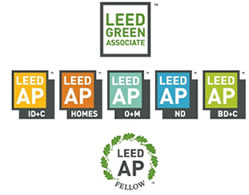No products in the cart.
Difference Between LEED Green Associate & LEED AP Credentials
When you first begin your research on LEED Certification, you become bombarded with a set of new terminology and acronyms that you may not have come across before. LEED Certification, LEED Accreditation, LEED CMP, LEED Green Associate, LEED AP, LEED AP BD+C, USGBC, GBCI – the list goes on a bit further, but I’ll spare you. It’s not hard to become overwhelmed almost immediately. If you’re looking to earn a LEED credential and add one of those fancy acronyms after your name on your resume or business card, what you really want to know is: which LEED designation should I pursue?
 The LEED Green Associate designation is the first step in a LEED professional’s journey. It provides a strong foundation for green building principles and teaches basic terminology to acquaint yourself with the industry.
The LEED Green Associate designation is the first step in a LEED professional’s journey. It provides a strong foundation for green building principles and teaches basic terminology to acquaint yourself with the industry.
Professionals working in non-technical roles, such as product manufacturers, marketers, salespeople, support staff, analysts, designers, and students, may be interested in learning about the LEED Rating System and demonstrating that knowledge with the LEED Green Associate credential.
That’s not to say that LEED Green Associates don’t work on LEED projects; they certainly can. LEED Green Associates are not excluded from working on LEED projects. However, these folks generally upgrade to what’s called a LEED AP with a specialty.
LEED AP with Specialty
The LEED AP with Specialty represents an individual who has passed the LEED Green Associate exam and decided to enhance his or her technical skills with a more advanced LEED designation. All LEED APs with Specialty are required to pass the LEED Green Associate exam before anything else.
From there, a professional is able to demonstrate advanced knowledge in a specialized area of green building and LEED Certification by pursuing a LEED AP Specialty. There are five specialties available:
- Building Design + Construction
- Operations + Maintenance
- Interior Design + Construction
- Neighborhood Development
- Homes
These specialties exist to help practitioners actively working on LEED projects to showcase their deep technical knowledge of LEED in both principle and practice. LEED AP with Specialty credential holders possess a deep understanding of all the details, prerequisites, credits, definitions, and rules of a particular specialty track within the LEED green building rating system. After all, all projects seeking LEED Certification must apply within one of these specialty tracks. The LEED AP professional simply aligns his or her technical skill set with such a specialty track to be able to better assist with those types of projects.
The LEED AP credential is perfect for architects, engineers, designers, and facility managers who are key decision-makers in a LEED project. These individuals often work with the sponsors of a LEED project in order to shepherd them through the certification process and get the buildings certified.
What more can a LEED AP do that a LEED Green Associate cannot?
LEED professionals at all tiers are welcome to work on LEED projects in some capacity. Due to the advanced level of knowledge that LEED AP professionals have, they are more likely to hold leadership positions on the LEED project team and provide hands-on assistance. This may include any of the following:
- Offering advice on sustainable solutions early in the process
- Navigating the LEED Online software to register a LEED project
- Selecting an appropriate rating system under which the LEED project should be certified
- Setting a goal for which level of LEED Certification to pursue – Certified, Silver, Gold, Platinum
- Determining which LEED credits to pursue
- Choosing and prioritizing sustainable features and materials for the project
- Coordinating team members and delegating responsibilities
- Completing templates and paperwork within LEED Online and submitting all documentation
Project teams welcome the contributions of a LEED AP not only for their technical knowledge and experience but also because LEED projects can earn an extra point toward LEED Certification simply by having a LEED AP working on the team. Projects applying for LEED Certification under v4 standards must have a LEED AP with a specialty aligned with the project’s desired specialty track. Projects applying for LEED Certification under 2009 standards may utilize the expertise of a LEED AP with any specialty knowledge.
It should be noted that it is NOT a requirement that team members possess a LEED credential. However, as you can imagine, the knowledge would only be advantageous. Earning a LEED Green Associate or LEED AP credential makes you a stronger contributor.
We teach LEED exam prep courses for three credentials – LEED Green Associate, LEED AP BD+C, and LEED AP O+M. If you’re looking to learn more about sustainability and green building, get started today with the LEED Green Associate Exam Prep! If you plan to take a more active role on green building projects, you may consider upgrading to a LEED AP with Specialty later. When the time comes, we’ll be happy to assist you with that goal!
